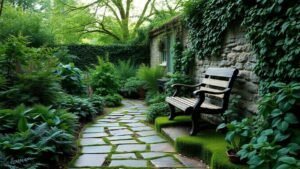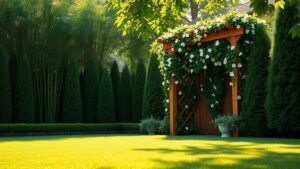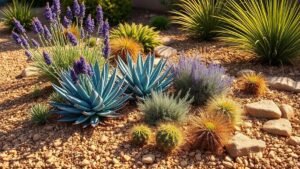Fast-Growing Plants for quick privacy screening in residential yards
Fast-Growing Plants for quick privacy screening in residential yards are my shortcut to turning boring fences into cozy green fortresses. I rely on arborvitae and holly for steady cover, trust Leyland cypress and poplar for speed, and treat bamboo like a delightful (but sometimes wild) roommate. Below are the spacing, planting, root barrier, pruning, and container tricks I use — with easy tips and a plan that helps birds and pollinators too.
Key takeaway
- Use clumping bamboo for fast vertical screening; tame running bamboo with a barrier.
- Leyland cypress and Thuja (Green Giant) hide views fast.
- Arborvitae is great for narrow hedges.
- Stagger plantings and keep shears handy — pruning speeds density.
- Mix evergreens and flowering shrubs for year-round privacy and wildlife value.
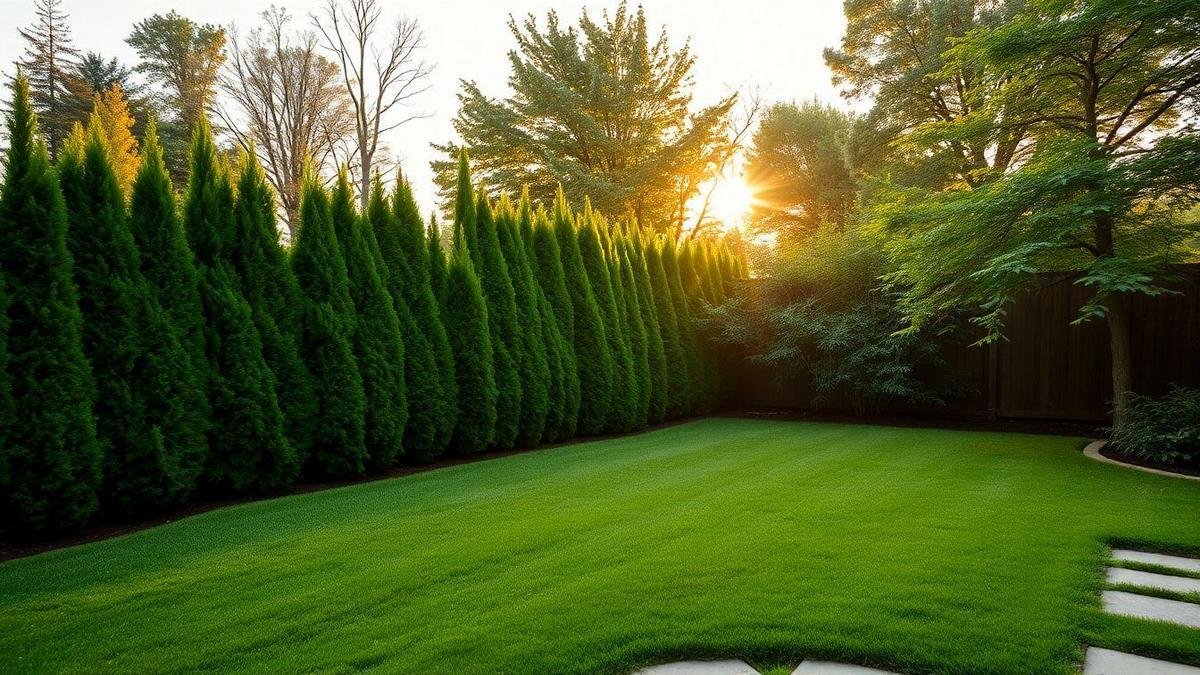
My go-to list of best Fast-Growing Plants for quick privacy screening in residential yards
When I need a fast screen, I choose plants that grow tall, fill in dense, and don’t make me regret it after year two.
Fast-growing evergreen privacy shrubs: arborvitae and holly
I plant arborvitae for a skinny, tall hedge and Nellie R. Stevens holly for dense leaves and winter berries.
Spacing I use:
- Arborvitae: 3–5 ft apart for a quick wall.
- Holly (Nellie R. Stevens): 6–8 ft apart.
| Shrub | Typical growth/yr | Mature height | Best for |
|---|---|---|---|
| Arborvitae (Green Giant types) | 3–4 ft/yr | 30–60 ft | Fast tall screens |
| Nellie R. Stevens Holly | 1.5–3 ft/yr | 15–25 ft | Dense, year-round cover |
| Dwarf/Compact Hollies | 1–2 ft/yr | 6–12 ft | Shorter hedges, formal looks |
Quick tip: stagger rows like brickwork, water well the first two summers, and do a bold shaping in year two to build density.
Fast-growing privacy trees: Leyland cypress and poplar
Trees give rapid vertical privacy, but watch roots and spacing.
| Tree | Growth/yr | Mature height | Cautions |
|---|---|---|---|
| Leyland Cypress | 3–4 ft/yr | 40–60 ft | Needs pruning; keep from foundations |
| Hybrid Poplar | 5–8 ft/yr | 40–70 ft | Shorter lifespan; suckers and mess |
Plant with a wide drip-line mulch ring and a root plan to reduce future fuss.
Fast-growing bamboo for privacy — what I watch for
Bamboo is a vertical rocket. I prefer clumping bamboo (Fargesia) for contained covers and only use running bamboo with a proper root barrier.
| Bamboo type | Spread behavior | Why I pick it |
|---|---|---|
| Clumping bamboo | Tight clumps | Easy to contain; great vertical screen |
| Running bamboo | Sends rhizomes far | Fast but can escape; needs barrier |
Watch for rhizomes, neighbor complaints, and install a 30–36 inch barrier for running types if you choose them.

How I space and plant quick privacy screen plants for fast results
I use Fast-Growing Plants for quick privacy screening in residential yards as my go-to trick. Exact steps:
- Test drainage and amend heavy clay with compost or coarse sand.
- Plant the root ball level with the soil — no crown burying.
- Mulch 2–3 in. (keep mulch 2–3 in. away from stems).
- Water deeply once or twice a week the first seasons; consistent beats heroic watering — pair this with water-saving practices or capture runoff with a DIY rainwater collection system to keep irrigation efficient.
Spacing guidelines I use:
| Plant (common) | Spacing I use | Typical growth speed |
|---|---|---|
| Privet | 3–4 ft apart | Fast (1–3 ft/yr) |
| Thuja (Green Giant) | 6–8 ft apart | Fast (2–3 ft/yr) |
| Leyland Cypress | 6–8 ft apart | Fast (3–4 ft/yr) |
| Clumping Bamboo | 3–5 ft apart | Fast (varies) |
| Photinia | 4–6 ft apart | Fast (1–2 ft/yr) |
Use temporary fillers (tall grasses or trellised vines) while screens fill in.
Root barriers and planting depth I recommend
- Root ball level with surrounding ground. Tease container roots; slice if circling.
- For aggressive roots (running bamboo): install a root barrier 30–36 in deep, top edge protruding 2–3 in above soil. Angle slightly outward and cut horizontal runners yearly.
- Materials I use: HDPE plastic for bamboo, heavy landscape fabric for less aggressive spreaders, concrete or metal for long-term fixes.
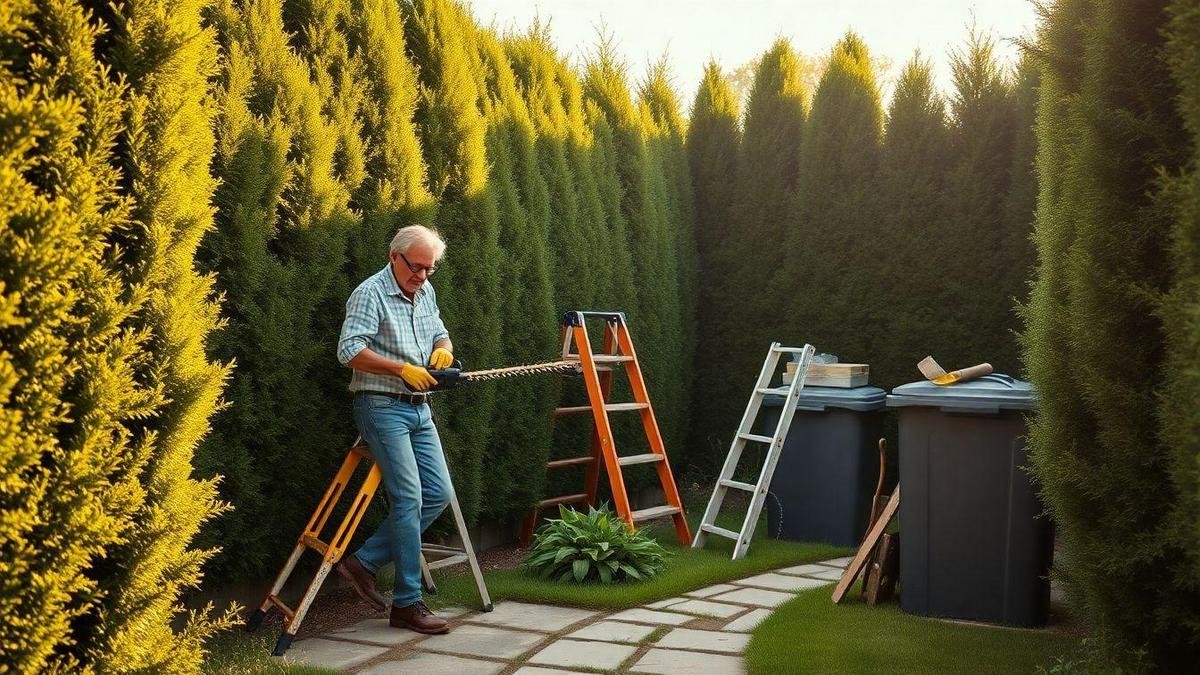
Care & maintenance — pruning, feeding, mulching
Prune to keep hedges tidy and dense. I trim so they’re narrower at the top than the base so light reaches lower foliage.
| Plant type | Best time | How often | Goal |
|---|---|---|---|
| Fast evergreen hedges (Leyland, Thuja) | Late spring (after new growth) | Light trim 2–3×/yr; thin out once/yr | Keep height & shape |
| Broadleaf evergreens | Late spring/early summer | Light shaping twice/yr | Maintain density |
| Young plants | Early spring | Train monthly first 2 years | Build a strong frame |
Pruning rules:
- Prune on dry days.
- Use sharp tools for clean cuts — learn the best pruning techniques for different hedge types.
- Mark a target height with tape to avoid overcutting.
Feeding & mulching:
| Task | When | What I use | Why |
|---|---|---|---|
| Slow-release fertilizer | Early spring | Balanced granular (low salt) | Steady growth |
| Light boost | Mid-summer (if pale) | Water-soluble feed | Quick green-up |
| Mulch | Spring & top-up fall | Organic, 2–3 in. deep | Holds moisture & cuts weeds |
I prefer organic inputs: slow-release organic fertilizers and soil amendments and homemade compost from a backyard compost bin. Practical rules: keep a mulch donut (away from trunks), water after fertilizing, and don’t overfeed.
Dealing with pests and disease
My three-step approach:
- Spot it early — yellow leaves, sticky residue, chewed tips.
- Remove affected branches and dispose of them.
- Treat smart: natural pest control like insecticidal soap for bugs; targeted fungicide or improved airflow for fungal issues.
Other habits: avoid overhead night watering, space plants for airflow, and encourage beneficial insects like ladybugs.
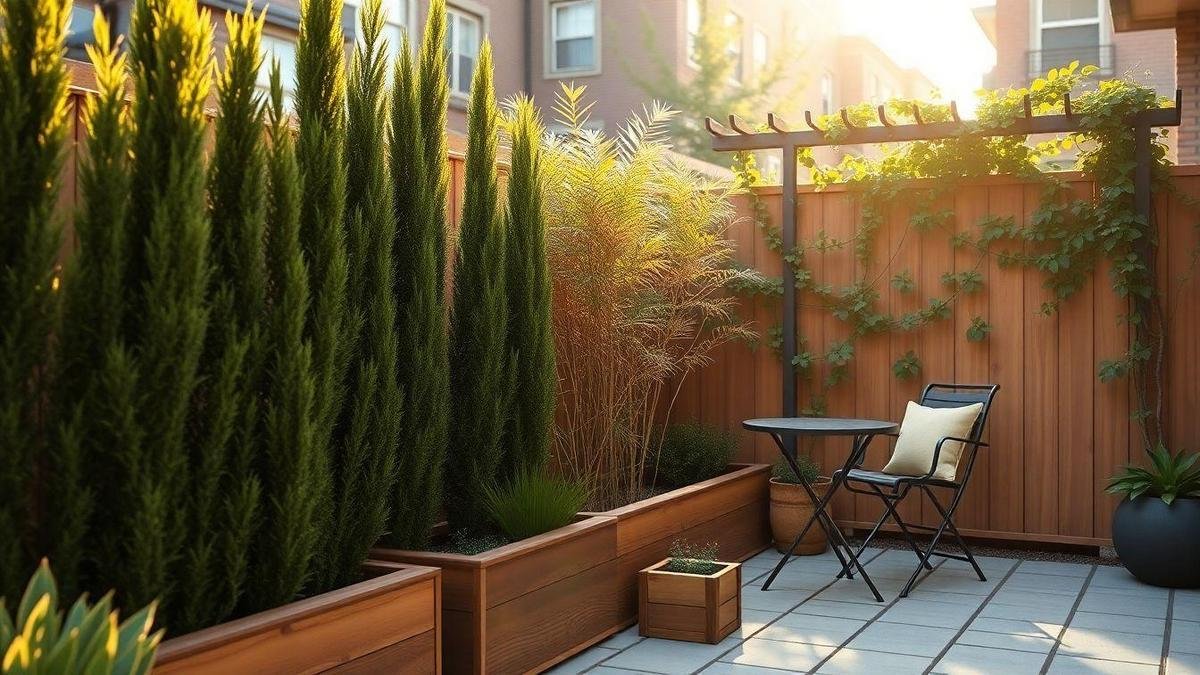
Fast solutions for small yards: compact plants, containers, and climbers
If ground space is limited, use containers, raised beds, and compact fast growers. I like mixes that give immediate cover and long-term structure.
Compact privacy plants I recommend:
| Plant | Mature height | Growth rate | Notes |
|---|---|---|---|
| Boxwood (Buxus) | 3–6 ft | Slow–Medium | Tight hedges and shaping |
| Dwarf Alberta Spruce | 6–10 ft | Slow | Columnar, narrow |
| Japanese Holly (Ilex crenata) | 4–8 ft | Medium | Dense leaves, tidy form |
| Clumping Bamboo (Fargesia) | 6–12 ft | Fast | Tall screen without spread |
| Yew (dwarf forms) | 3–8 ft | Medium | Shade tolerant, prunes well |
Container tips:
- Use tall, narrow pots to save floor space — see practical choices in container plants for small patios.
- Choose well-draining mixes and add slow-release fertilizer.
- Use a trellis and soft ties for vines.
- Water more often and check roots year to year.
Climbing plants for fences:
- Honeysuckle, clematis, and climbing hydrangea are great options for tight spaces — they give instant leaf cover on a vertical plane.
- For step-by-step care, I follow simple training methods for climbing plants: add simple trellis/wires, tie shoots loosely, prune in late winter.
Training tips: add simple trellis/wires, tie shoots loosely, prune in late winter.
If space is extremely tight, combine these ideas with small garden layout tricks and plant lists for city living and urban gardens.
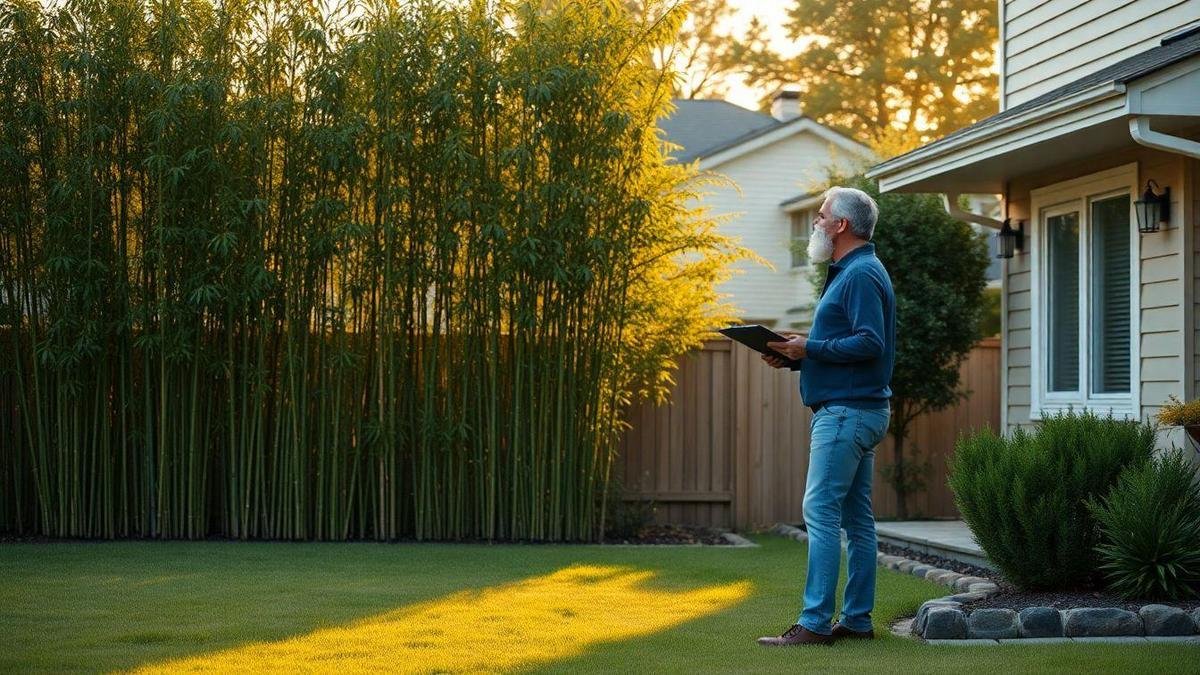
Laws, neighbors, and invasive tendencies
I always check local codes, HOA rules, and chat with neighbors before planting. It saves fights and fines.
What I check:
- Typical height limits (often 6–8 ft for front yards).
- Setbacks from property lines and sidewalks.
- Permits for large plantings or tall trees.
Managing invasive tendencies:
- Prefer clumping over running types.
- Use barriers, pots, or raised beds for risky species.
- Trim and dig runners yearly and cut seed heads before they drop.
Installing root barriers — my method
- Mark planting line and dig a trench 30–36 in for running bamboo (18–24 in for other spreaders).
- Install HDPE or concrete, leaving top edge 2–3 in above soil.
- Angle bottom slightly outward, backfill, water, and check edges twice a year.
| Material | Depth I use | Cost note |
|---|---|---|
| HDPE (plastic) | 30–36 in (running bamboo) | Moderate |
| Concrete | 24–36 in | Higher cost, long-lasting |
| Galvanized metal | 24–36 in | Durable, pricier |
Mixing for year-round cover, sound buffering, and wildlife
Pair evergreens for winter privacy with deciduous shrubs for flowers, berries, and habitat. I plant strips: low flowerers (front), medium shrubs (middle), and tall evergreens (back).
Pairing examples:
- Thuja ‘Green Giant’ Viburnum — tall green wall spring flowers and berries.
- Leyland cypress Serviceberry — evergreen screen early blooms for birds.
- Clumping bamboo Elderberry — dense stalks food for birds; this combination fits well into a plan for a wildlife-friendly garden or when choosing native plants that support local wildlife.
Fast growers that help pollinators and birds:
| Plant | Speed | Pollinators & birds | Tip |
|---|---|---|---|
| Buddleia (butterfly bush) | Fast | Attracts butterflies | Deadhead for more blooms |
| Sambucus (Elderberry) | Fast | Bees; berries for many birds | Mass in hedgerows |
| Amelanchier (Serviceberry) | Medium-fast | Early bees; berries for birds | Great spring show |
| Willow (Salix) | Very fast | Supports many insects & birds | Use near moist soil |
If pollinator habitat is a priority, include several species from plant lists that attract pollinators.
Quick hedgerow favorites
- Elderberry (Sambucus) — fast, lots of berries.
- Buddleia — bright blooms for butterflies.
- Serviceberry — early flowers, sweet berries.
- Viburnum (native) — spring flowers, fall color, berries.
- Thuja ‘Green Giant’ — tall, quick privacy.
- Clumping Bamboo — dense, vertical screen (clumping types only).
- Willow (Salix) — super fast where soil is moist.
I once mixed these and had privacy in a season — birds moved in immediately.
Conclusion
I turned a boring fence into a green fortress using Fast-Growing Plants for quick privacy screening in residential yards. My formula: choose the right fast grower for the spot, stagger plantings, install root barriers for risky species, water consistently, mulch well, and prune to shape. Mix evergreens with flowering shrubs for year-round privacy and wildlife benefits. Measure twice, plant once — and never plant running bamboo without a moat (ask me how I learned).
Want more plant lists and practical tricks? Read more at https://myxaro.com.
Frequently asked questions
Which fast-growing plants give privacy the quickest?
Bamboo (clumping), Leyland cypress, and arborvitae — you can see a screen in 1–3 years depending on species and care.
How fast do these plants really grow?
- Bamboo can jump a foot or more in a month.
- Leyland cypress ~3–4 ft/yr.
- Arborvitae ~2–3 ft/yr. Soil and water affect rates.
Which are low-maintenance for quick screening?
Clumping bamboo, tall ornamental grasses, and Thuja/Green Giant arborvitae — minimal fuss beyond occasional trimming. For curated lists of easy-care choices, see low-maintenance garden plant recommendations.
Can I plant them near fences or my house?
Avoid running bamboo near fences. Use root barriers for runners and keep trees 10–15 ft from foundations when possible.
What’s the best mix for Fast-Growing Plants for quick privacy screening in residential yards?
I use clumping bamboo at corners, fast conifers (Leyland/Thuja) in the middle, and tall grasses or flowering shrubs as fillers. This gives fast cover, sound buffering, and a wildlife-friendly screen — combine that with native and pollinator-friendly choices from native plant guides and lists of pollinator-friendly species.


